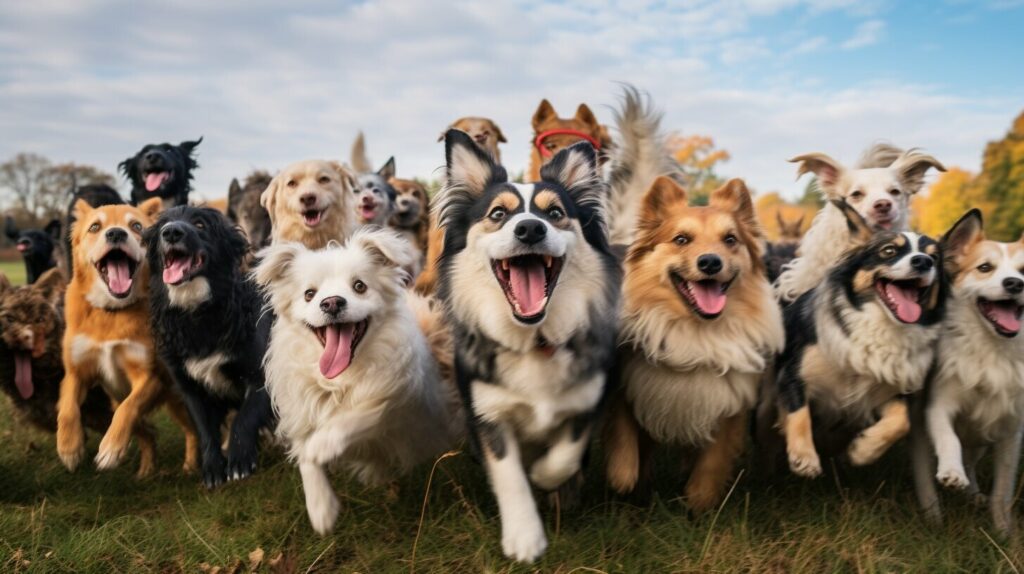If you’re a dog owner or trainer, you know the importance of communication with your furry friend. Training them to behave in certain ways can be challenging without the right tools. Introducing barking dogs sounds to your training regimen can be incredibly beneficial. With realistic and diverse sounds, you can simulate real-life scenarios and help your dog become accustomed to different sounds and situations.
Dogs are social animals with unique communication styles that include barking, growling, whining, and howling. As a dog owner, understanding these vocalizations is crucial for effective training. Using sound cues can be associated with rewards to encourage desired behaviors, which is where barking dog sound effects come in handy.
Key Takeaways:
- Barking dogs sounds can be very helpful in dog training
- Understanding dog vocalizations is crucial for effective training
- Barking dog sound effects can be associated with rewards to encourage desired behaviors
Understanding Canine Vocalizations
If you are a dog owner, it is essential to understand your dog’s different vocalizations to communicate better and train them effectively. Dogs use a variety of vocalizations to express their feelings and communicate with their owners and other dogs.
The most common vocalization is barking, which dogs use for various reasons, such as alerting their owners, expressing happiness or excitement, or barking to get attention. Growling is another vocalization that dogs often use when they feel threatened or want to show aggression. Whining is a sound that dogs use when they want something or feel uncomfortable, while howling is a vocalization used by dogs to communicate with other dogs over long distances.
Understanding your dog’s vocalizations is crucial when it comes to training your furry friend. By paying attention to the sounds they make, you can start to differentiate their different needs, wants, and emotions. To train your dog effectively, you must learn to identify and respond to different vocalizations.
Harnessing the Power of Barking Dog Sound Effects
Using sound effects in dog training can be highly effective, and barking dog sound effects are no exception. These sounds can simulate real-life scenarios and help dogs become accustomed to different sounds, reducing their anxiety and fear. However, it’s important to use high-quality and realistic sound effects for the best results.
Barking dog sound effects can be obtained from various sources, including sound libraries and online platforms. These can range from pre-recorded sound effects to customizable sound playlists and smartphone applications. When selecting sound effects, ensure that they are suitable for the dog’s breed, age, and training needs.
Integrating barking dog sound effects into training sessions can be achieved in many ways. For example, you can create a customized sound playlist that includes a variety of barking dog sounds in different volumes and intensities. Gradually increase the volume and intensity of the sound to avoid overwhelming or distressing the dog.
Another effective training technique is to incorporate barking dog sound effects into desensitization and counterconditioning methods. These methods help dogs overcome fear or anxiety associated with certain sounds, encouraging desired behaviors.
When using barking dog sound effects, ensure that you observe the dog’s reactions and adjust the training accordingly. The goal is to use sound effects as a positive reinforcement tool, not to cause distress or anxiety.
The Role of Barking Dogs Sounds in Behavioral Training
Understanding canine vocalizations is essential in addressing dog behavior problems. Barking is the most common vocalization, and it indicates various emotions or states of mind. By using barking dogs sounds in your training, you can modulate and shape your dog’s behaviors positively.
The concept of positive reinforcement is fundamental when using barking dogs sounds in behavioral training. Positive reinforcement consists of rewarding good behavior and ignoring undesirable behaviors. Thus, when you introduce barking dogs sounds and associate them with treats or other rewards, your dog learns to associate the sound with good behavior.
Some of the behaviors that you can address with barking dogs sounds include excessive barking, aggression, separation anxiety, and fear of loud noises. For example, by using barking dogs sounds in a training session, you can simulate a real-life situation, such as a stranger approaching your property. You can use sound cues to instill calm and relaxed behavior in your dog and associate it with positive reinforcement. Thus, the sound of dogs barking can help your dog recognize and differentiate between friends and foes.
When using barking dogs sounds in training, it is also crucial to observe your dog’s reactions. It’s important to make sure that the sound level is safe and comfortable for your dog, as overly loud or intense sounds can be distressing. Gradually increase the volume and intensity of the sound as your dog becomes accustomed to it, but avoid overwhelming your dog.
In conclusion, barking dogs sounds can help you communicate with your dog and modify their behavior. By using barking dogs sounds, you can simulate real-life situations and teach your dog how to react appropriately. Remember, barking dogs sounds, when used correctly with positive reinforcement, can be a powerful tool in your arsenal of dog training techniques.
Using Barking Dogs Sounds for Socialization
If you have a new puppy or a dog that hasn’t been exposed to many different sounds, you may notice that they become fearful or aggressive when they hear dogs barking freely. This is a common problem that can be addressed with proper socialization. By introducing your dog to barking dogs sounds in a controlled environment, you can help them become more comfortable and less reactive to these sounds in the future.
Exposing your dog to barking dogs sounds is particularly important if you live in an urban area or near other dogs. Hearing dogs barking noises can be a regular occurrence, and you want your dog to feel comfortable and safe in their environment.
When introducing your dog to barking dogs sounds, start with a low volume and gradually increase it over time. You want to make sure your dog is not overwhelmed or distressed by the sounds. You can use a smartphone app or pre-recorded sounds of barking dogs to play for your dog.
It’s important to observe your dog’s reactions during the socialization process. If they seem fearful or anxious, take a break and try again later. You can also use positive reinforcement techniques, such as giving your dog treats or praise, to help them associate barking dogs sounds with positive experiences.
Training Techniques with Barking Dogs Sounds
Now that you understand the benefits of using barking dogs sounds in training, let’s explore some techniques for incorporating them into your sessions.
Desensitization is a common method used to gradually expose dogs to the sound of barking dogs. This technique involves starting with low-level sounds and gradually increasing the intensity or volume over time. Begin by playing the sound of a dog barking at a very low volume and reward your dog for any calm or relaxed behavior. Gradually increase the volume over several training sessions, always being mindful of your dog’s reactions. The goal is to help your dog become accustomed to the sound and associate it with positive experiences.
Counterconditioning is another technique that can be used to modify a dog’s response to barking dogs sounds. This technique involves pairing the sound of barking dogs with something positive, such as treats or playtime. Every time your dog hears the sound of barking dogs, offer them a reward or engage in a fun activity. This will help your dog form positive associations with the sound and reduce any negative reactions.
To incorporate barking dogs sounds into your training, you can create a playlist of different sound effects that mimic real-life scenarios, such as doorbells ringing or car horns honking. You can use these sound effects to train your dog to react appropriately to different situations. For example, you can play the sound of a doorbell ringing and train your dog to go to their designated spot or to greet guests politely.
Remember to always use high-quality and realistic barking sound effects to ensure the best results. Also, pay attention to your dog’s reactions and adjust the volume and intensity of the sound accordingly. With these techniques, you can effectively use barking dogs sounds to modify and shape your dog’s behavior.
Tips for Using Barking Dogs Sounds Safely
When using barking dogs sounds for training, it’s essential to prioritize your dog’s safety and well-being. Here are some tips to ensure a safe and positive experience:
- Start with low volume and intensity: Gradually increase the volume and intensity of the sound to avoid overwhelming or distressing your dog.
- Observe your dog’s reaction: Pay attention to your dog’s body language and behavior while playing the sound. If your dog becomes anxious or fearful, lower the volume or stop the sound altogether.
- Reinforce positive behavior: Always associate barking dogs sounds with positive reinforcement, such as treats or praise, to encourage desired behavior.
- Use in a controlled environment: Always use barking dogs sounds in a controlled environment, such as during training sessions at home or in a secure outdoor area.
- Get professional guidance: If you’re unsure about how to use barking dogs sounds safely and effectively, consider consulting with a professional dog trainer or behaviorist.
By following these guidelines, you can create a safe and positive training experience for you and your furry friend, making the most out of the benefits of barking dogs sounds.
Exploring Available Resources for Barking Dogs Sounds
If you’re on the hunt for high-quality barking dogs sounds, there are several resources available to you. Here are some options to consider:
Online Sound Libraries
There are many websites that offer free or paid access to sound libraries that include barking dogs sounds. These libraries may offer a variety of options, from individual barking sounds to full soundscapes with multiple dogs barking. Some popular online sound libraries include SoundBible, Freesound, and AudioJungle.
Pre-Recorded Sound Effects
If you’re looking for specific barking dogs sound effects, pre-recorded options are readily available. These sound effects can be found on websites like Amazon or purchased from specialty sound effect vendors. Make sure to choose high-quality sounds that closely mimic real-life barking dogs.
Customizable Sound Playlists
If you’re in need of a range of barking dog sounds, consider creating a customizable sound playlist. This can be done using a program like Audacity, which allows you to mix and match different barking dog sounds to create your own custom playlist.
Smartphone Applications
There are several smartphone applications available that offer barking dog sound effects. These apps may offer features like customizable playlists, volume control, and adjustable sound effects. Some popular barking dog sound effect apps include Dog Whistle, Dog Sounds, and Dog Training Sounds.
Regardless of where you source your barking dogs sounds, make sure to choose high-quality, realistic sounds to achieve the best results in your dog training sessions.
Real-Life Testimonials on the Effectiveness of Barking Dogs Sounds
If you’re still not convinced about the effectiveness of barking dogs sounds in dog training, here are some real-life testimonials from dog owners and trainers:
“As a professional dog trainer, I always make use of sound cues to communicate with dogs. The barking dogs sound effects have been particularly helpful in teaching my clients’ dogs to differentiate between friendly and threatening sounds. The improvement in their behavior has been remarkable!” – Sarah K.
Many dog owners have also reported positive changes in their dogs’ behavior after incorporating barking dogs sounds into their training sessions.
- “My dog used to be terrified of fireworks and thunderstorms, but after regularly exposing him to barking dogs sound effects, he has become less anxious and more relaxed during these events.” – John D.
- “Teaching my dog to stop barking at the mailman was a daunting task until I discovered the power of barking dog noises. By associating the sound with a treat, my dog now remains calm when the mailman arrives.” – Karen S.
The versatility of barking dogs sounds has also been praised by dog trainers:
“I’ve used dog barking sound effects to train not only behavior but also agility and obedience. The ability to simulate different scenarios with realistic sound effects has made my job so much easier.” – Mark T.
These testimonials demonstrate the effectiveness of barking dogs sounds in dog training and the positive impact they can have on a dog’s behavior.
Conclusion
You now have a better understanding of the significance of barking dogs sounds in dog training. By incorporating realistic and diverse sounds into your training routine, you can simulate real-life scenarios and help your dog become accustomed to different sounds. Understanding the different types of canine vocalizations and the reasons behind them can give you insight into your dog’s behavior and help you modify it.
With the right barking dogs sounds and training techniques, you can modify and shape your dog’s behavior in a positive way. As you explore different resources for barking dogs sounds, remember to prioritize safety and gradually increase the volume and intensity of the sound. Observe your dog’s reactions and adjust your training accordingly.
We encourage you to utilize the power of barking dogs sounds in your training sessions and share your experiences with others. If you have any questions or comments, feel free to reach out to us. Happy training!
FAQ
Q: What are barking dogs sounds?
A: Barking dogs sounds are audio recordings or sound effects that mimic the sounds of dogs barking. These sounds can be used in various applications, including dog training and behavior modification.
Q: How can barking dogs sounds help with dog training?
A: Barking dogs sounds can be used to simulate real-life scenarios and train dogs to respond to different sounds. By associating specific behaviors or commands with the barking dogs sounds, trainers can effectively communicate their expectations to the dogs.
Q: Where can I find high-quality barking dogs sound effects?
A: There are several resources available online where you can find high-quality barking dogs sound effects. These resources include specialized sound libraries, online platforms, and smartphone applications.
Q: Can barking dogs sounds be used to address specific behavioral issues?
A: Yes, barking dogs sounds can be used to address specific behavioral issues in dogs. By using sound cues and positive reinforcement, trainers can modify and shape dog behavior.
Q: How should I introduce my dog to barking dogs sounds?
A: It is important to gradually introduce dogs to barking dogs sounds in a positive and controlled manner. Start with low volume and gradually increase it as the dog becomes comfortable. Observe the dog’s reactions and adjust the training accordingly.
Q: Are barking dogs sounds safe to use in training?
A: When used appropriately, barking dogs sounds are safe to use in training. However, it is important to gradually increase the volume and intensity of the sound to avoid overwhelming or distressing the dog. Always observe the dog’s reactions and adjust the training accordingly.
Q: Can barking dogs sounds be used for socialization purposes?
A: Yes, exposing dogs to barking dogs sounds can aid in their socialization process. By familiarizing dogs with different sounds, they can become less fearful or aggressive towards unfamiliar noises.
Q: Are there any success stories or testimonials from using barking dogs sounds?
A: Yes, many dog owners and trainers have shared their success stories and testimonials about the effectiveness of using barking dogs sounds in training. These stories highlight the positive changes observed in dogs’ behavior and the overall effectiveness of incorporating sound effects into training routines.



